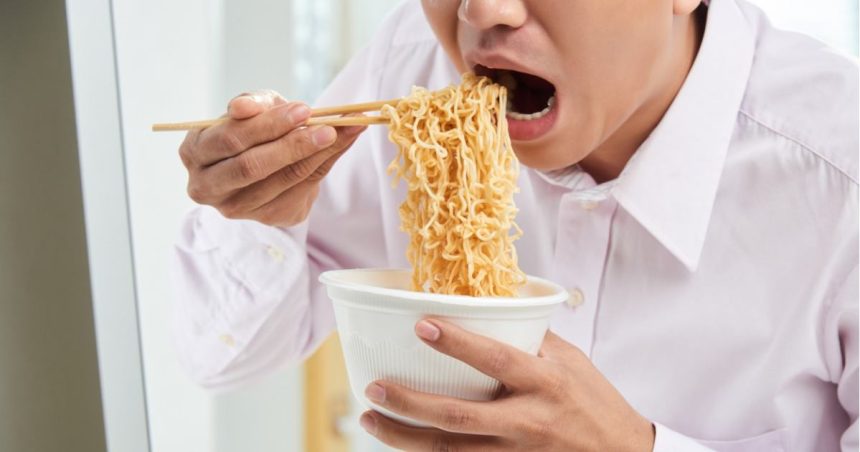Instant noodles are easy to make and don’t cost much money, but they don’t have as much nutrition. They also contain a considerable quantity of salt. This article examines instant noodles objectively so that you may make the proper judgment about whether or not this convenient item belongs to a balanced diet.
What’s in Instant Noodles?
The following is the nutritional breakdown of one serving (43 grams) of instant noodles to give you a hint:
- 385 kilocalories
- 55.7 g of carbohydrates
- 14.5 grams total fat
- Fats 5 grams
- 7.9 grams of protein
- 2 grams of fibre
- Sodium Content 986mg
- Thiamine (vitamin B1) 0.6 mcg
- 4.6 milligrams niacin
- riboflavin, 0.4mg
Why instant noodles are called unhealthy?
The preservative
The food industry makes considerable use of tertiary butyl hydroquinone, or TBHQ, as a preservative. It prevents the rancidity of processed foods and prolongs their shelf life. The maximum quantity allowed by the FDA in food is 0.02%. More significant quantities of this chemical may cause sickness, ringing in the ears (tinnitus), vomiting, and the inability to speak clearly.
Bisphenol A
There is a potential that certain instant noodle packets’ Styrofoam inserts contain this chemical. This chemical may disrupt a woman’s natural estrogen levels. It may cause issues with the neurological system and immune system, and it may also raise the risk of acquiring diseases such as diabetes, cardiovascular disease, metabolic disorders, and Alzheimer’s.
Poor flour quality
The majority of instant noodle brands mainly consist of maida. This refined and bleached flour may be used to make a variety of foods, including bread, pizza, and samosas. This flour has many calories that are not worth consuming. The white hue is the result of the bleaching process.
The majority of instant noodle brands mainly consist of maida. This refined and bleached flour may be used to make a variety of foods, including bread, pizza, and samosas. This flour has many calories that are not worth consuming. The white hue is the result of the bleaching process.
White grain is stripped of vital vitamins, dietary fibre, and minerals such as iron, phosphorus, selenium, magnesium, and manganese during the refining process. This occurs during the milling of grains into flour.
This refined product is hazardous to one’s health since it may increase the likelihood of obesity, diabetes, constipation, and other digestive issues. In order to synthesize it, potentially dangerous ingredients Sodium Meta Bisulphate (SMBS) and Benzoic acid are used. Long-term exposure to these chemicals may cause asthma-like allergic reactions, coughing, shortness of breath, skin rashes, reproductive issues, and cancer.
MSG
This flavour enhancer may be used for instant noodles, canned vegetables, deli meat, and soups. Consuming MSG in moderation is harmless; nevertheless, large amounts have been associated with Chinese restaurant syndrome, obesity, metabolic irregularities, and reproductive issues.
Side Effects
Weight gain
The biggest worry in the modern world is obesity, which is related to liver damage and renal failure. The production of maize is an essential byproduct of instant. The refined flour used to manufacture the noodles is primarily responsible for the dish’s greasiness.
High Blood Pressure
The sodium level in instant noodles leads to hypertension, one of the adverse effects that also includes obesity. Due to the high salt content of instant noodles, you must eat them. Have you ever seen a person sweating after consuming them? The quantity of salt in your diet leads to a rise in your blood pressure.
Liver damage
Propylene glycol, which may be toxic to the liver and leads to its malfunction, is one of the dangerous ingredients in instant noodles.
Causes cancer
A significant percentage of persons of varied ages may approach cancer in an uncomplicated way. And Instant Noodles have become a kind of this disease that afflicts us. Instant noodles wrapped in Styrofoam, which contain a substantial number of chemicals and other potentially dangerous substances, may contribute to the development of cancer.
Cardiovascular disease
Moreover, instant noodles may be found in harmful junk food and vitamin-deficient diets. The use of instant noodles is consistently connected with a high risk of heart disease.
Fats
Before being packed, instant noodles are cooked in palm oil, lard, or butter; thus, they often contain a high level of saturated fat. The taste may also include oils that are very high in unsaturated fats. When ingested in excess or on a regular basis, wet fats may raise the level of low-density lipoprotein in the blood. High cholesterol levels raise the likelihood of getting cardiovascular disease.
The issue of malnutrition in kids
Youngsters are far more likely to be engaged in captivating advertisements. You could not easily ignore your child’s requests as a parent. Some parents believe that it is sufficient to fill their child’s stomach with anything, even instant noodles.
Stroke mortality
Not only are high blood pressure and heart disease connected to the use of salty instant noodles, but there is also a relationship between the consumption of instant noodles and stroke-related mortality rates.
Healthier Ways to Enjoy Instant Noodles
Colour your plate for additional vitamins
Consider adding colourful toppings to your instant noodles if you want to increase the number of vitamins you consume and ensure that you consume the daily recommended amount of veggies. You are only restricted by your own imagination when determining which veggies pair well with instant noodles, but vegetables are an excellent complement to these noodles in general. As a first step in the correct direction, a “rainbow” bowl is an excellent target to shoot at. Choose a vegetable that corresponds to each hue of the rainbow and includes it in the meal if you want to increase the vitamin and nutrient density of your noodles.
Select iron-rich dark green vegetables, such as spinach and kale. Many phytochemicals in green vegetables have been shown to have anti-cancer properties. Vegetables like eggplant and red cabbage contain anthocyanin, a plant pigment that protects cells from damage, reduces the risk of cancer, and enhances heart and lung health. Eating foods such as red cherry tomatoes and red bell peppers may help maintain a healthy heart.
Instead of adding more salt, consider including fresh textures
The majority of instant noodle variations come with flavour sachets and toppings already included in the packaging, which significantly enhances the taste intensity. If you need to add more flavour to your noodles using seasonings in addition to the flavour sachets, you may want to add unique textures for variety rather than more taste. As noodles are silky and smooth, you may attempt topping them with crunchy or crispy textures. These may include braised pork belly or pork crackling, Thai-style noodles, cashews, or even julienned and honey-glazed fresh carrots. If you want your instant noodles to taste more like ramen, add a hard-boiled egg and some broth.
Sweet vegetables are a healthy alternative to using sugary sauces
Some of the most popular noodle sauces, including fish sauce, sweet chilli sauce, soy sauce, and miso paste, include added sugars and are high in salt. Instead of using one of these low-nutrient sauces, consider garnishing your plate with some sweet vegetables for a tasty alternative. Adding sliced snow peas to instant noodles is a natural way to sweeten them, as well as a terrific way to add texture to the meal. You may also use thinly sliced cabbage, spiralized zucchini or butternut squash, and thinly sliced carrots for a sweeter, more nutritious meal.
If you have a strong affinity for a sauce or paste, try using fresh herbs and spices as a substitute and then blending these elements to create your own unique concoction. The addition of chopped chile, sesame oil, ginger, garlic, and shrimp paste may improve a dish’s taste and intensity. Coriander leaves, mint, and basil are examples of herbs that bring a touch of sweetness and freshness to a dish. After adding a squeeze of lime, you will never look at that bottle of fish sauce in the same way again.
Add steamed veggies
The pairing of delicious vegetables with instant noodles is a gourmet marriage made in heaven. Hence, consider steaming your vegetables instead of stir-frying them. When you steam your vegetables, you maintain not just their colour and taste but also their nutritional value. What effects does this have on your instant noodle packages? A more savoury and healthful meal! There are many types of vegetables that may be steamed, but bok choy, broccoli, asparagus, carrots, and artichokes are some of our favourites that go nicely with noodles. Not only are these vegetables delicious and nutritious, but they are also sturdier and won’t quickly turn to mush, a vital attribute for a noodle-based dish.
Give a topping with a high fibre content
You should add fibre to your regular consumption of instant noodles, especially if you are seeking to lose weight since instant noodles are often low in fibre. There are several ways in which fibre is advantageous for us, particularly for our digestive health. Fibre preserves the health of the bacteria in your stomach, which alleviates bloating and constipation symptoms and promotes weight loss by suppressing appetite for more extended periods of time. You may increase the fibre content of your instant noodles by consuming foods that are naturally high in fibre or by choosing a brand of instant noodles produced with whole grains.
Select Baked Options for a Healthier Diet
Generally speaking, fried noodles contain around 20 grams more fat per serving than their non-fried counterparts. Instead of frying, low-fat noodles are prepared by steaming and baking them the whole time. As a consequence, they contain far less fat and have a springier texture, making them both palatable and nutritious.
Conclusion
Noodles do not classify as either nutritious or unhealthy by themselves. Just mix water, flour, and a couple of pinches of salt. It is essential to consider both the way in which these components are manufactured and the additional components that are coupled with them. When correctly cooked, it is not only nutritious but also delicious.
About Author: The content is written by Maha. She has five years of experience in writing personal wellness and health articles.














